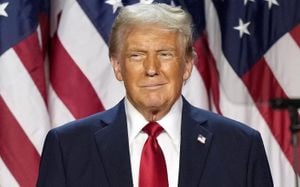The impact of policies instituted during the Trump administration reverberates through the financial markets, creating ripples of speculation and debate among investors, economists, and public policy analysts alike. While many aspects of his presidency have drawn fierce scrutiny, the effects of his administration's decisions on everything from stock prices to interest rates merit closer examination. At the crux of this discussion is not just how markets reacted to Trump's policy announcements, but also how those policies shaped investor sentiment and market behaviors leading up to the recent elections.
A pivotal element of the Trump administration was its approach to tax reform, particularly the Tax Cuts and Jobs Act (TCJA) passed at the end of 2017. This legislation significantly reduced the corporate tax rate, dropping it from 35% to 21%. Supporters claimed this would stimulate investment and lead to job creation, arguing it threw fuel on the fire of the already bullish market ignited during the Obama administration. By lowering taxes on businesses, the administration aimed to encourage companies to repatriate foreign earnings and invest domestically. Indeed, many companies reported increased capital expenditures following the tax cuts, but critics pointed out the benefits were not universally shared. Instead, they argued the cuts principally enriched shareholders through stock buybacks rather than translating to increased wages for workers.
Fast forward to 2024, and another major discussion point has surfaced around interest rates and inflation. The Federal Reserve, which plays a significant role in shaping market conditions, has dramatically adjusted its policies to counteract inflationary pressures. Under Chairman Jerome Powell, the Fed increased rates multiple times throughout 2022 and 2023, effectively tightening monetary policy to temper excessive consumer spending and stabilize prices. This shift, initiated against the backdrop of flagging economic growth, brought waves of volatility to the markets—especially those closely tied to technology and consumer discretionary stocks, which were often more sensitive to interest rate fluctuations.
What’s particularly interesting is how Trump’s blistering criticisms of the Federal Reserve have resurfaced as he seeks to reclaim the presidency. His previous comments chiding the Fed for rate hikes serve as reminders to market watchers of how political influence can interlace with monetary policy decisions. If he finds success once more, the tug-of-war between fiscal ambitions and monetary policy may spark anew, stirring investor anxieties about regulatory intervention and the administration's approach to economic stewardship.
But it wasn’t just the Fed’s actions or the tax cuts affecting the markets; Trump also stirred the pot with his trade policies, particularly with China. The administration's pivot to enforce tariffs on Chinese imports sought to counteract what he termed unfair trade practices. While the intent was to bolster U.S. manufacturing jobs, swift retaliation from China often saw American farmers and manufacturers negatively impacted, leading to job losses and regional economic distress. Stocks across various sectors—particularly agriculture and manufacturing—fluctuated wildly during the peak of trade tensions, creating uncertainty for those directly affected by tariffs and counter-tariffs.
The market also felt the turbulence of Trump's sometimes erratic communication style, particularly on social media. Tweets on trade negotiations or regulatory changes often resulted in immediate market ennui. For example, informal announcements of tariff increases or changes to pending trade agreements could see stock markets rise or plummet within hours. Investors had to navigate the new normal of swift market changes based on rapidly delivered news through channels like Twitter.
Of course, the COVID-19 pandemic threw another wild card onto the table, presenting challenges none could have anticipated. The ensuing economic crisis saw the implementation of stimulus packages and direct distributions to citizens, which flooded money back to consumers. Interestingly, the economic recovery fueled by stimulus and easy access to credit saw the stock markets reach unprecedented highs once again, often disconnected from underlying economic fundamentals. Investors became increasingly engaged with high-risk assets, including tech stocks, driving up valuations well beyond traditional metrics.
Now, as Trump seeks another shot at the presidency, eyes are closely fixed on how his potential re-election could reshape strategies on Wall Street. Investors are left wondering how past Trump administration policies will echo through the chambers of power again—would there be more tax cuts, another bout with inflation, or even heavier-handed trade negotiations?
The buzz within market circles points to heightened volatility as he campaigns, small and large investors alike prepare for unexpected shifts. The fine line between his populist rhetoric and the realities of fiscal governance creates both opportunities and risks. Analysts suggest the success or failure of Trump policies may come to be viewed through the lens of market reactions—if stocks soar amid expectations of loosening regulations and tax incentives, or conversely if tariffs spin back rapidly, choking market growth.
For many, the overarching question remains: how do you navigate investment landscapes shaped by political uncertainty? Each election year brings its own dynamics, and with Trump back on the stage, it's anyone's guess how Wall Street will react. It’s not just Trump's return to the helm; it's the policies, the rhetoric, and the uncertainties surrounding them, all leaving investors to brace for another chapter of market unpredictability.
To sum things up, one cannot simply observe the correlation between Trump policies and the markets without digging beneath the surface. The psychological element of investing blatantly shines through as narratives around leadership shape the direction of investment flows, stock performance, and economic growth outlooks.
With the new elections just around the corner, and the specter of increased volatility looming, many investors find themselves at the crossroads of hope and anxiety. Perhaps the most important factor is not just who wins, but how the influences—and any possible continuities or shifts—shape the financial landscapes moving forward. Only time will tell, but keeping bearish and bullish assumptions well informed by factual developments will likely prove more beneficial than simply riding the waves of speculation alone.



